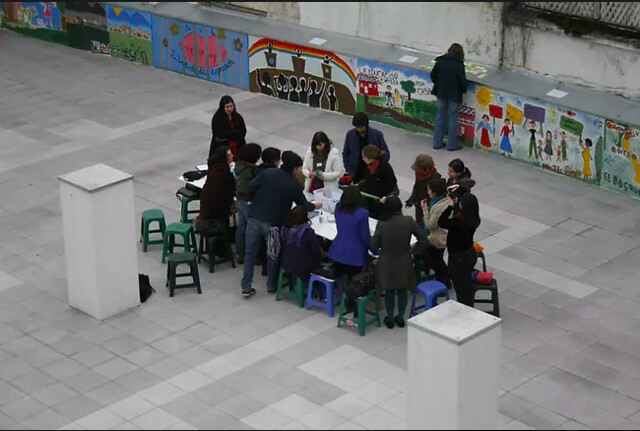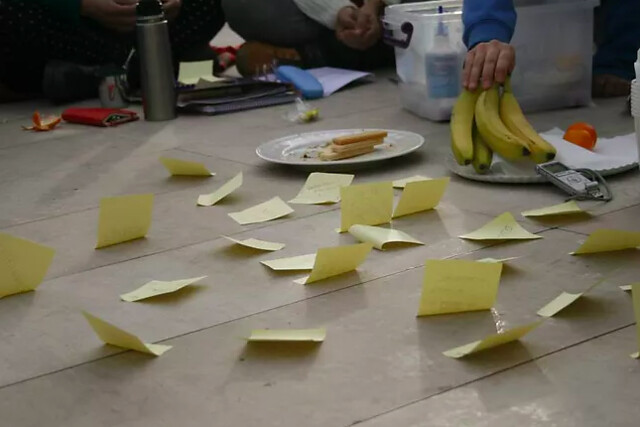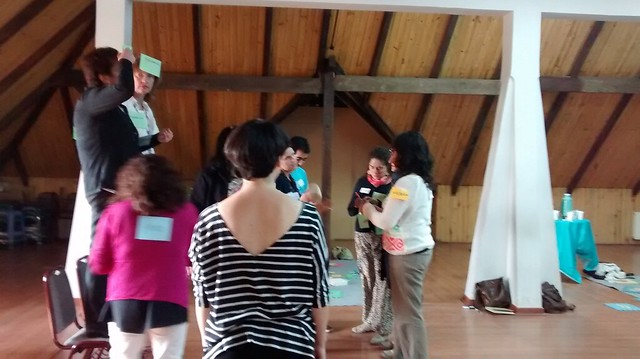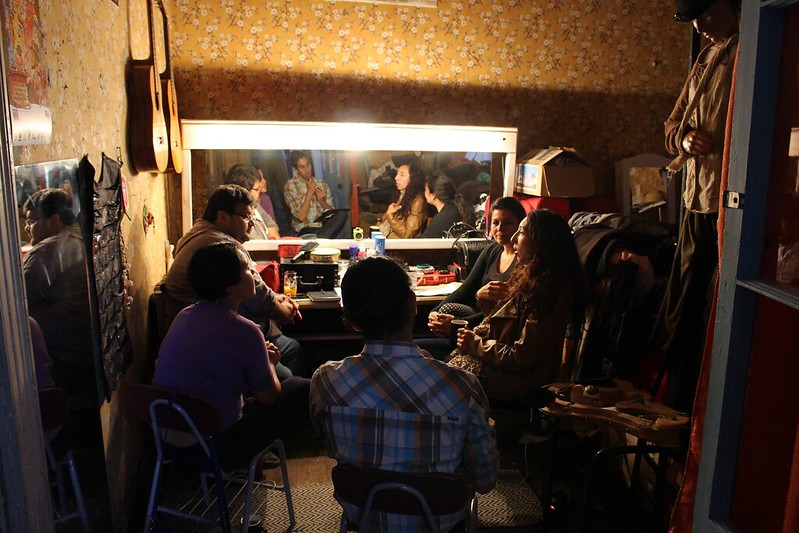The field of artistic mediation gradually takes shape through the creation of spaces for encounters and reflections. This is why activities designed to delve into what artistic mediation is, its purpose, and how it is carried out are indispensable.
These spaces are typically labeled as training activities. However, because it is crucial to put theory into practice, the methodology I have employed to design these activities transforms them into mediation activities in their own right. Consequently, they resemble instances where experiences are shared, and as one teaches, they also glean insights from the experiences and knowledge of others.
2013 / Symposium “Educating for Transformation: The Role of Artistic Education in the Legacy of Paulo Freire and Mario Pedroza”
This event marked one of the initial open gatherings convened at the MSSA to deliberate and contemplate education and artistic mediation. Leveraging the exhibition commemorating the 40th anniversary of the museum’s inception, where the curatorial team sought to spotlight the Brazilian art critic Mario Pedroza, we aimed to create a thematic context by intertwining it with another prominent Brazilian figure who left an enduring impact on Chile: the educator Paulo Freire.
Built around the tenets of Freire’s Critical Pedagogy and the populist curatorial concepts of Mario Pedroza, we extended invitations to popular educators, formal educators, and museum educators to partake in panel discussions. These discussions culminated in mediation activities designed to stimulate the exchange of ideas and the generation of new knowledge.


2014-2015 / WORKSHOP CREATIVE PROCESSES AND EDUCATIONAL PRACTICES
As a way to consistently activate the core of contemporary art exhibitions at the MSSA, an opportunity was created for teachers and educators to participate in a workshop alongside the artists from each exhibition cycle. These artists shared their creative processes, and together, they rehearsed and analyzed ways to transform them into educational tools tailored to the needs and contexts of each educator. Artists such as Claudia del Fierro, Gabriel Holzapfel, and Rafael Guendelman participated in this initiative.

2014 / Collaborative Pedagogies (With the Artistic Mediation Network)
This collaborative endeavor took place at the Chimkowe cultural center in Peñalolén, Santiago, during August 2014. It comprised three meetings involving educators from the community who approached pedagogical work from diverse perspectives and within different educational contexts (formal and non-formal). Despite their varying backgrounds, they shared a critical perspective on the traditional educational practices that are currently facing challenges.
Within this context, integrated activities were introduced, incorporating the performing arts during the first and second meetings. These activities focused on bodily exploration and the potential for interaction using non-traditional (non-verbal) communication methods. These experiences proved to be highly informative regarding the kinds of relationships individuals can establish with their peers and their surroundings. In contrast, the third meeting centered around visual arts and took a more concrete and practical approach. It involved applying these dynamics to achieve outcomes with both reflective and tangible dimensions, providing tangible evidence of the process. (Taken from https://www.redmediacionartistica.cl/pedagogas-en-colaboracin-2014)


2016 / Introduction to Artistic Mediation Workshop for Teachers / Arts Education Week
As part of the IV Arts Education Week, this workshop was presented to introduce and familiarize the characteristics and main methodologies of artistic mediation to arts teachers and educators from various disciplines in the Coquimbo region.
Designed as an introductory session, the workshop lasted for 4 hours and aimed primarily to provide an experiential and reflective exploration of artistic mediation as a pedagogical and didactic tool. It sought to introduce the fundamental principles of this practice, its origins, initiate discussions regarding pedagogical and didactic approaches within artistic mediation, and outline its potential applications in teaching practices within the classroom.
The workshop adopted a methodology based on the principles of artistic mediation, adaptable to the needs and interests of the participants. Consequently, new topics and contents emerged during its execution, fostering dynamic discussions.
For more details and photos, please refer to the report.
2016 / Artistic Mediation Program for Schools ACCIONA Program in the IV Region
ACCIONA is an art education program operated by the National Council for Culture and the Arts, currently the Ministry of Culture, the Arts, and Heritage (MINCAP). For over 15 years, it has brought workshops, activities, and artistic-cultural experiences to rural and economically disadvantaged school communities. It primarily achieves this by pairing an artist-educator with a teacher. One of its main objectives is to achieve true integration of artistic disciplines and methodologies into the school curriculum, where dialogue and mutual knowledge transfer between artist-educators and teachers are of great importance.
Starting in 2016, I was able to work on various stages and functions of implementing this program in the Coquimbo Region as a freelancer. This initial workshop served as an introduction for the teachers and artist-educators who were already working together. The goal was to improve their communication, create spaces for discussion and reflection on the role of the arts in their communities, and share working methodologies.
For more details and photographs, please refer to the report.
2017 / Convergence
This was a self-organized event in which, through an open call and free participation, we invited mediators, educators, artists, and anyone interested to come together for an exchange of experiences and methodologies aligned with artistic mediation. Thus, Confluencias is conceived as a space for collective learning where we aim to recognize ourselves as a community belonging to a territory. We are capable of continuously rethinking and reconfiguring established notions regarding the implications of artistic practices, institutionalization, cultural production, and other related topics.
We had broad and diverse participation from local actors who are currently reflecting on – and in some cases, discovering – the potential of artistic mediation as a field of action, both in theory and practice. These participants come from diverse fields such as psychology, architecture, and performing arts, among others. In this sense, we are pleased to know that despite all the existing challenges at the regional level – such as connectivity issues in the case of the fourth region – and the overarching difficulties faced by cultural and arts professionals in the country – like the lack of spaces, resources, and training opportunities – there are many individuals and organizations developing interesting research and action experiences in the field of arts, both within institutional frameworks and in independent and self-managed spaces. (Taken from https://www.redmediacionartistica.cl/confluencias)
2017 / Artistic Mediation Laboratory for the ACCIONA Program
Within the scope of the work carried out by the ACCIONA program in participating schools of the IV region, the Artistic Mediation Network (RMA) was called upon by the CNCA to create a training opportunity specifically aimed at artist educators. This was intended to support their work in schools.
Based on a preliminary diagnosis conducted by the National Council of Culture and the Arts in the Coquimbo Region, it was observed that the work of artist-educators with teachers tended to focus on procedural aspects. In other words, they mainly transmitted knowledge of artistic techniques (drawing, painting, ballet, etc.) and did not position themselves as a transdisciplinary tool that promotes reflection and transformation within educational communities.
As a response to this, a working session was proposed in the format of an Artistic Mediation Laboratory (Lab Med), which RMA had previously conducted in other contexts. This format allows for an initial approach to the field of mediation as a space for exploration in the arts and as a platform for creating collective learning experiences. It also enables the strengthening and forging of connections between the arts, art education, and local cultural actors. Mediation is positioned as a platform for meeting, exploration, and knowledge production, where exploration is based on the perspectives of the participants. This approach helps define, from their own sensitivities, a contextually grounded and critical sense of artistic mediation.
For more details and photographs, please refer to the report.
2017 / Open Classroom Project: Educational Heritage Workshops and School Memory in High Schools in the Historic Center of La Serena.
As part of the Open Classroom Project, funded by the Regional FONDART, I was invited to participate in the creation and implementation of a mediation activity open to project teachers and the interested public. The focus was on museology and pedagogical museography, along with three sessions for students participating in the heritage brigades of the Gregorio Cordovez, Gabriela Mistral, Germán Riesco, and Seminario Conciliar high schools in La Serena. These sessions covered critical museography and heritage mediation.
This was an opportunity to address topics such as museography and heritage using tools of reflection, dialogue, and the creation of artistic mediation.


2018 / Artistic Mediation Laboratory in Performing Arts LABM
This project developed as a continuation of the 2017 Confluencias meeting, with a clearer understanding of the needs and characteristics of regional cultural actors.
In this way, performing arts – especially theater, dance, and circus – were identified as relevant fields to initiate the work of the LABMAs. This initiative became a reality through the project “Artistic Mediation Laboratory in Performing Arts for Artists and Artistic Educators,” funded by the Regional FONDART, Training Activities Line, 2018. It consisted of 4 sessions, each lasting 4 hours, with the support of the Cultural Palace and the Gabriela Mistral Regional Library. These sessions were held on April 14th, April 21st, May 5th, and May 12th, 2018, with the last session rescheduled to June 1st at the Remolino Educational Circle.
The sessions aimed to create a space for reflection, practice, and creation centered around artistic mediation in the context of performing arts. The goal was to establish a network of collaboration and cooperation that would produce practical tools related to artistic mediation. Each session focused on a specific theme and involved experienced mediators from the Artistic Mediation Network.
Report and logbook are available here:
2019 / Educating in Movement with La Manada Dance Collective
This project was a collaborative and group training initiative in which we had the participation of renowned choreographers, dancers, and dance educators. We also welcomed the entire local community interested in dance and movement.
In addition to handling management and production tasks within this project, I was involved in systematization and the creation of activities related to artistic mediation.


